Human-Centric Lighting: Rare-Earth-Free Photoluminescent Materials for Correlated Color Temperature Tunable White LEDs
Abstract
1. Introduction
1.1. Our Modern Relationship with Light
1.2. Circadian Rhythms, Light and Health
1.3. Rare-Earth-Free Tunable White LEDs
2. Results and Discussion
2.1. Design of WLEDs
2.2. Optical Characterization
2.2.1. Spectral Power Distribution (SPD)
2.2.2. Color Rendering Index (CRI)
2.2.3. Correlated Color Temperature (CCT)
2.3. Monolayer Luminescent Molecular Systems
2.4. Multilayer Luminescent Molecular Systems
2.5. Tunable and Rare-Earth-Free WLEDs
3. Materials and Methods
3.1. Selection of the Materials
3.2. Experimental Details and Methods
4. Conclusions
Author Contributions
Funding
Institutional Review Board Statement
Informed Consent Statement
Data Availability Statement
Conflicts of Interest
References
- Münch, M.; Wirz-Justice, A.; Brown, S.A.; Kantermann, T.; Martiny, K.; Stefani, O.; Vetter, C.; Wright, K.P.; Wulff, K.; Skene, D.J. The Role of Daylight for Humans: Gaps in Current Knowledge. Clocks Sleep 2020, 2, 61–85. [Google Scholar] [CrossRef] [PubMed]
- Irwin, A. The Dark Side of Light: How Artificial Lighting Is Harming the Natural World. Nature 2018, 553, 268–270. [Google Scholar] [CrossRef] [PubMed]
- Sanders, D.; Gaston, K.J. How Ecological Communities Respond to Artificial Light at Night. J. Exp. Zool. Part A Ecol. Integr. Physiol. 2018, 329, 394–400. [Google Scholar] [CrossRef] [PubMed]
- Gaston, K.J.; Visser, M.E.; Hölker, F. The Biological Impacts of Artificial Light at Night: The Research Challenge. Philos. Trans. R. Soc. B Biol. Sci. 2015, 370, 20140133. [Google Scholar] [CrossRef]
- Falcón, J.; Torriglia, A.; Attia, D.; Viénot, F.; Gronfier, C.; Behar-Cohen, F.; Martinsons, C.; Hicks, D. Exposure to Artificial Light at Night and the Consequences for Flora, Fauna, and Ecosystems. Front. Neurosci. 2020, 14, 1183. [Google Scholar] [CrossRef]
- Gaston, K.J.; Duffy, J.P.; Gaston, S.; Bennie, J.; Davies, T.W. Human Alteration of Natural Light Cycles: Causes and Ecological Consequences. Oecologia 2014, 176, 917–931. [Google Scholar] [CrossRef]
- Cho, Y.; Ryu, S.-H.; Lee, B.R.; Kim, K.H.; Lee, E.; Choi, J. Effects of Artificial Light at Night on Human Health: A Literature Review of Observational and Experimental Studies Applied to Exposure Assessment. Chronobiol. Int. 2015, 32, 1294–1310. [Google Scholar] [CrossRef]
- Svechkina, A.; Portnov, B.A.; Trop, T. The Impact of Artificial Light at Night on Human and Ecosystem Health: A Systematic Literature Review. Landsc. Ecol. 2020, 35, 1725–1742. [Google Scholar] [CrossRef]
- Osibona, O.; Solomon, B.D.; Fecht, D. Lighting in the Home and Health: A Systematic Review. Int. J. Environ. Res. Public Health 2021, 18, 609. [Google Scholar] [CrossRef]
- Erren, T.C.; Reiter, R.J. Light Hygiene: Time to Make Preventive Use of Insights—Old and New—Into the Nexus of the Drug Light, Melatonin, Clocks, Chronodisruption and Public Health. Med. Hypotheses 2009, 73, 537–541. [Google Scholar] [CrossRef]
- Walker, W.H.; Bumgarner, J.R.; Walton, J.C.; Liu, J.A.; Meléndez-Fernández, O.H.; Nelson, R.J.; DeVries, A.C. Light Pollution and Cancer. Int. J. Mol. Sci. 2020, 21, 9360. [Google Scholar] [CrossRef]
- Posadzki, P.P.; Bajpai, R.; Kyaw, B.M.; Roberts, N.J.; Brzezinski, A.; Christopoulos, G.I.; Divakar, U.; Bajpai, S.; Soljak, M.; Dunleavy, G.; et al. Melatonin and Health: An Umbrella Review of Health Outcomes and Biological Mechanisms of Action. BMC Med. 2018, 16, 18. [Google Scholar] [CrossRef]
- Shneider, A.; Kudriavtsev, A.; Vakhrusheva, A. Can Melatonin Reduce the Severity of COVID-19 Pandemic? Int. Rev. Immunol. 2020, 39, 153–162. [Google Scholar] [CrossRef]
- Provencio, I.; Rodriguez, I.R.; Jiang, G.; Hayes, W.P.; Moreira, E.F.; Rollag, M.D. A Novel Human Opsin in the Inner Retina. J. Neurosci. 2000, 20, 600–605. [Google Scholar] [CrossRef]
- Bailes, H.J.; Lucas, R.J. Human Melanopsin Forms a Pigment Maximally Sensitive to Blue Light (Λmax ≈ 479 Nm) Supporting Activation of Gq/11 and Gi/o Signalling Cascades. Proc. R. Soc. B Biol. Sci. 2013, 280, 20122987. [Google Scholar] [CrossRef]
- Newman, L.A.; Walker, M.T.; Brown, R.L.; Cronin, T.W.; Robinson, P.R. Melanopsin Forms a Functional Short-Wavelength Photopigment. Biochemistry 2003, 42, 12734–12738. [Google Scholar] [CrossRef]
- Thapan, K.; Arendt, J.; Skene, D.J. An Action Spectrum for Melatonin Suppression: Evidence for a Novel Non-Rod, Non-Cone Photoreceptor System in Humans. J. Physiol. 2001, 535, 261–267. [Google Scholar] [CrossRef]
- St Hilaire, M.A.; Ámundadóttir, M.L.; Rahman, S.A.; Rajaratnam, S.M.W.; Rüger, M.; Brainard, G.C.; Czeisler, C.A.; Andersen, M.; Gooley, J.J.; Lockley, S.W. The Spectral Sensitivity of Human Circadian Phase Resetting and Melatonin Suppression to Light Changes Dynamically with Light Duration. Proc. Natl. Acad. Sci. USA 2022, 119, e2205301119. [Google Scholar] [CrossRef]
- Sunde, E.; Pedersen, T.; Mrdalj, J.; Thun, E.; Grønli, J.; Harris, A.; Bjorvatn, B.; Waage, S.; Skene, D.J.; Pallesen, S. Alerting and Circadian Effects of Short-Wavelength vs. Long-Wavelength Narrow-Bandwidth Light during a Simulated Night Shift. Clocks Sleep 2020, 2, 502–522. [Google Scholar] [CrossRef]
- Bonmati-Carrion, M.A.; Arguelles-Prieto, R.; Martinez-Madrid, M.J.; Reiter, R.; Hardeland, R.; Rol, M.A.; Madrid, J.A. Protecting the Melatonin Rhythm through Circadian Healthy Light Exposure. Int. J. Mol. Sci. 2014, 15, 23448–23500. [Google Scholar] [CrossRef]
- Baglivo, C.; Bonomolo, M.; Congedo, P.M.; Beccali, M.; Antonaci, S. Technical-Economic Evaluation of the Effectiveness of Measures Applied to the Artificial Lighting System of a School. Appl. Sci. 2021, 11, 6664. [Google Scholar] [CrossRef]
- Ticleanu, C. Impacts of Home Lighting on Human Health. Light. Res. Technol. 2021, 53, 453–475. [Google Scholar] [CrossRef]
- Konstantzos, I.; Sadeghi, S.A.; Kim, M.; Xiong, J.; Tzempelikos, A. The Effect of Lighting Environment on Task Performance in Buildings—A Review. Energy Build. 2020, 226, 110394. [Google Scholar] [CrossRef]
- Heber, J. Nobel Prize 2014: Akasaki, Amano & Nakamura. Nat. Phys. 2014, 10, 791. [Google Scholar] [CrossRef]
- Sato, M.; Kim, S.W.; Shimomura, Y.; Hasegawa, T.; Toda, K.; Adachi, G. Rare Earth-Doped Phosphors for White Light-Emitting Diodes. In Handbook on the Physics and Chemistry of Rare Earths; Handbook on the Physics and Chemistry of Rare Earths; Elsevier B.V.: Amsterdam, The Netherlands, 2016; pp. 1–128. [Google Scholar]
- Anonymous. The New Oil? Nat. Photon. 2011, 5, 1. [Google Scholar] [CrossRef][Green Version]
- Krasovitskii, B.M.; Bolotin, B.M.; Vopian, V.G. Organic Luminescent Materials; VCH: Weinheim, Germany, 1988; ISBN 978-3-527-26728-6. [Google Scholar]
- Menéndez-Velázquez, A.; Mulder, C.L.; Thompson, N.J.; Andrew, T.L.; Reusswig, P.D.; Rotschild, C.; Baldo, M.A. Light-Recycling within Electronic Displays Using Deep Red and near Infrared Photoluminescent Polarizers. Energy Environ. Sci. 2013, 6, 72–75. [Google Scholar] [CrossRef]
- Mulder, C.L.; Reusswig, P.D.; Velázquez, A.M.; Kim, H.; Rotschild, C.; Baldo, M.A. Dye Alignment in Luminescent Solar Concentrators: I. Vertical Alignment for Improved Waveguide Coupling. Opt. Express OE 2010, 18, A79–A90. [Google Scholar] [CrossRef]
- Delgado-Sanchez, J.M.; Lillo-Bravo, I.; Menéndez-Velázquez, A. Enhanced Luminescent Solar Concentrator Efficiency by Foster Resonance Energy Transfer in a Tunable Six-Dye Absorber. Int. J. Energy Res. 2021, 45, 11294–11304. [Google Scholar] [CrossRef]
- Shen, L.; Lou, R.; Park, Y.; Guo, Y.; Stallknecht, E.J.; Xiao, Y.; Rieder, D.; Yang, R.; Runkle, E.S.; Yin, X. Increasing Greenhouse Production by Spectral-Shifting and Unidirectional Light-Extracting Photonics. Nat. Food 2021, 2, 434–441. [Google Scholar] [CrossRef]
- Sánchez-Lanuza, M.B.; Menéndez-Velázquez, A.; Peñas-Sanjuan, A.; Navas-Martos, F.J.; Lillo-Bravo, I.; Delgado-Sánchez, J.M. Advanced Photonic Thin Films for Solar Irradiation Tuneability Oriented to Greenhouse Applications. Materials 2021, 14, 2357. [Google Scholar] [CrossRef]
- Menéndez-Velázquez, A.; Núñez-Álvarez, C.; del Olmo-Aguado, S.; Merayo-Lloves, J.; Fernández-Vega, A.; Osborne, N.N. Potential Application of Photoluminescent Filters for Use in Ophthalmology. Opt. Mater. 2018, 86, 505–511. [Google Scholar] [CrossRef]
- Zang, C.; Xu, M.; Zhang, L.; Liu, S.; Xie, W. Organic–Inorganic Hybrid Thin Film Light-Emitting Devices: Interfacial Engineering and Device Physics. J. Mater. Chem. C 2021, 9, 1484–1519. [Google Scholar] [CrossRef]
- Mosca, M.; Macaluso, R.; Crupi, I. Hybrid Inorganic-Organic White Light Emitting Diodes. In Polymers for Light-Emitting Devices and Displays; John Wiley & Sons, Ltd.: Hoboken, NJ, USA, 2020; pp. 197–262. ISBN 978-1-119-65464-3. [Google Scholar]
- Menéndez-Velázquez, A.; Morales, D.; García-Delgado, A.B. Light Pollution and Circadian Misalignment: A Healthy, Blue-Free, White Light-Emitting Diode to Avoid Chronodisruption. Int. J. Environ. Res. Public Health 2022, 19, 1849. [Google Scholar] [CrossRef]
- Menéndez-Velázquez, A.; Morales, D.; García-Delgado, A.B. Sunlike White Light-Emitting Diodes Based on Rare-Earth-Free Luminescent Materials. Materials 2022, 15, 1680. [Google Scholar] [CrossRef]
- Erdem, T.; Demir, H.V. Color Science of Nanocrystal Quantum Dots for Lighting and Displays. Nanophotonics 2013, 2, 57–81. [Google Scholar] [CrossRef]
- Lee, H.-Y.; Le, P.X.; Nguyen, D.Q.A. Selecting a Suitable Remote Phosphor Configuration for Improving Color Quality of White Led. J. Adv. Eng. Comput. 2019, 3, 503–510. [Google Scholar] [CrossRef]
- Anh, N.D.Q.; Le, P.X.; Lee, H.-Y. Selection of a Remote Phosphor Configuration to Enhance the Color Quality of White LEDs. Curr. Opt. Photon. COPP 2019, 3, 78–85. [Google Scholar]
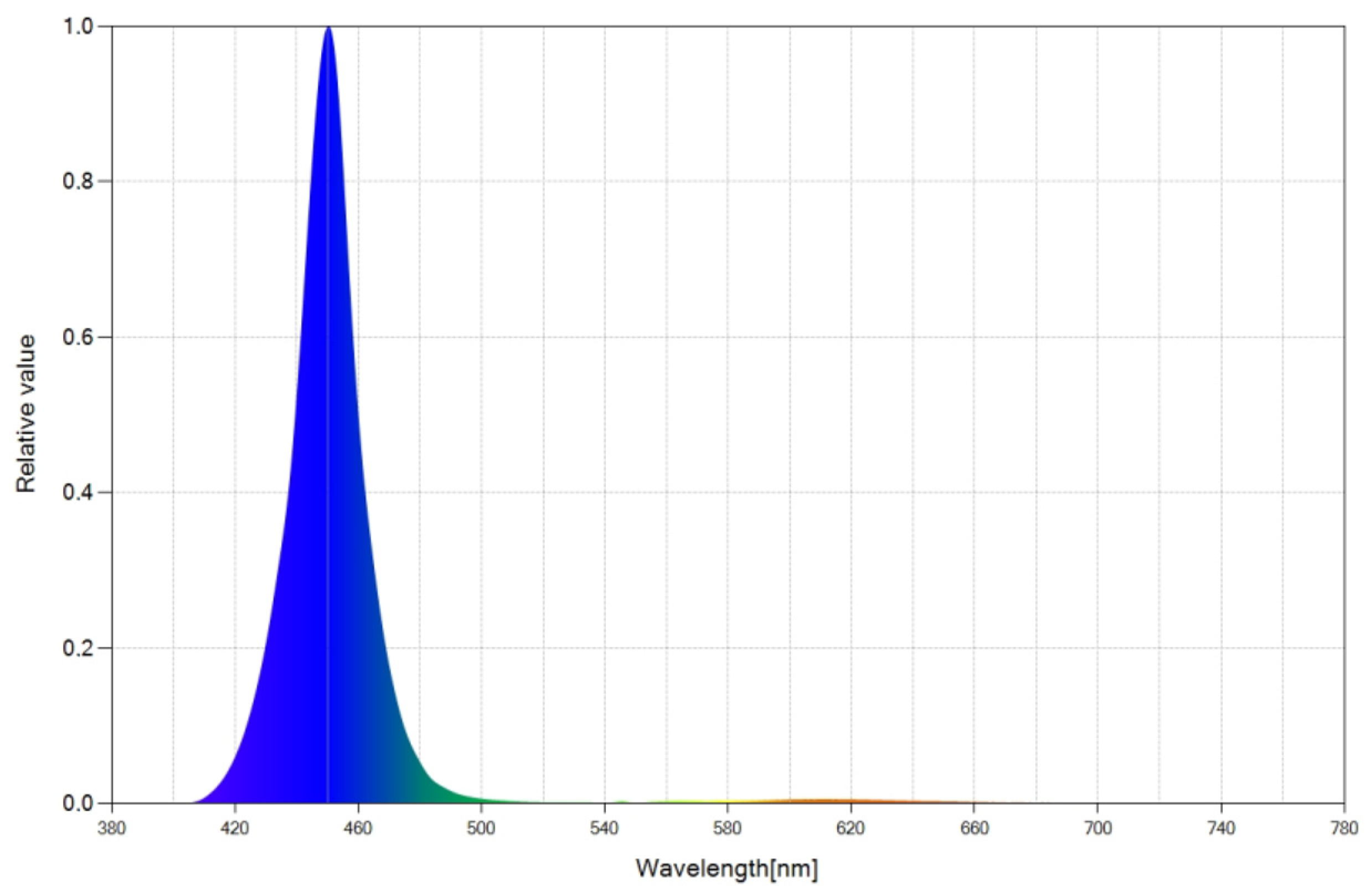

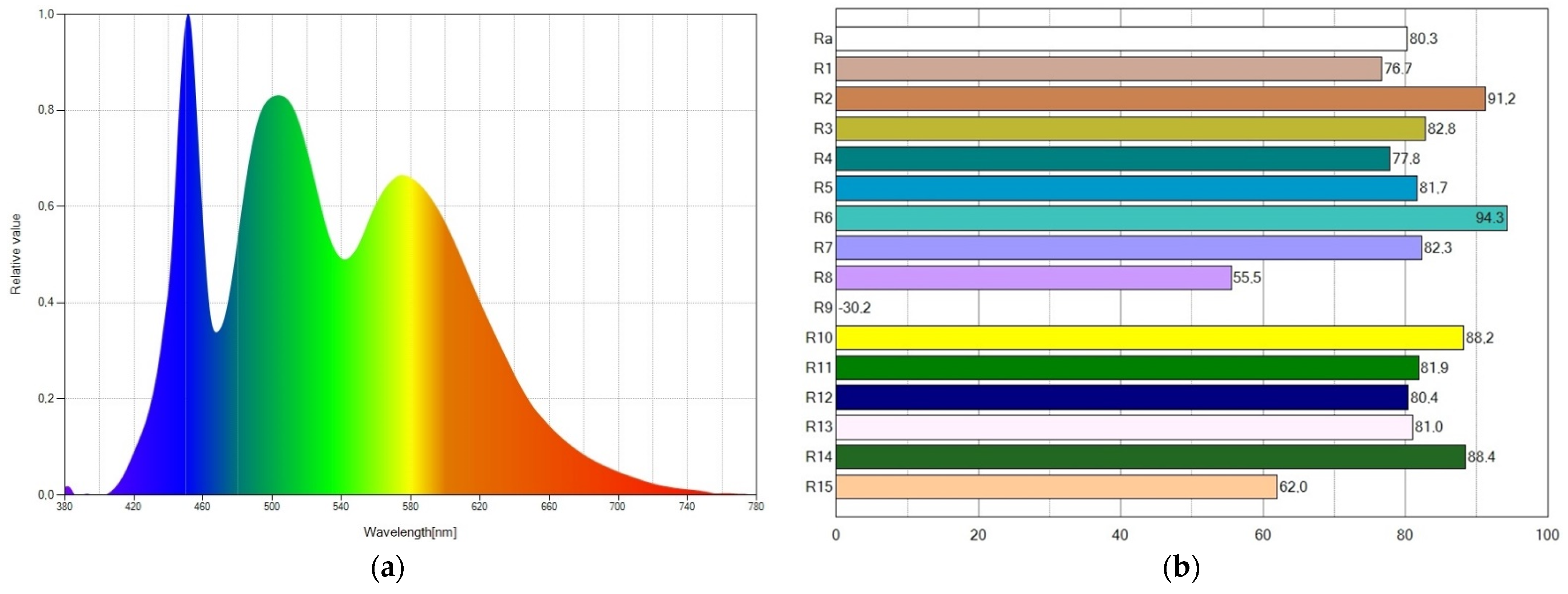

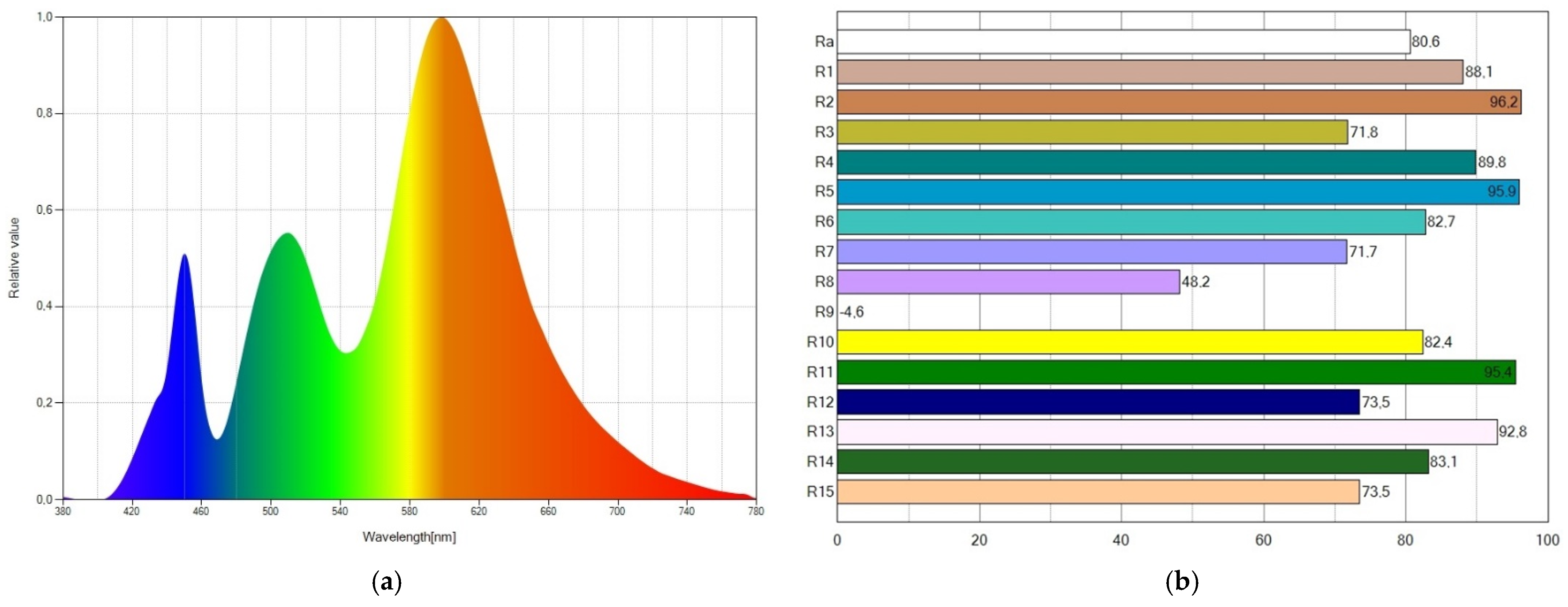
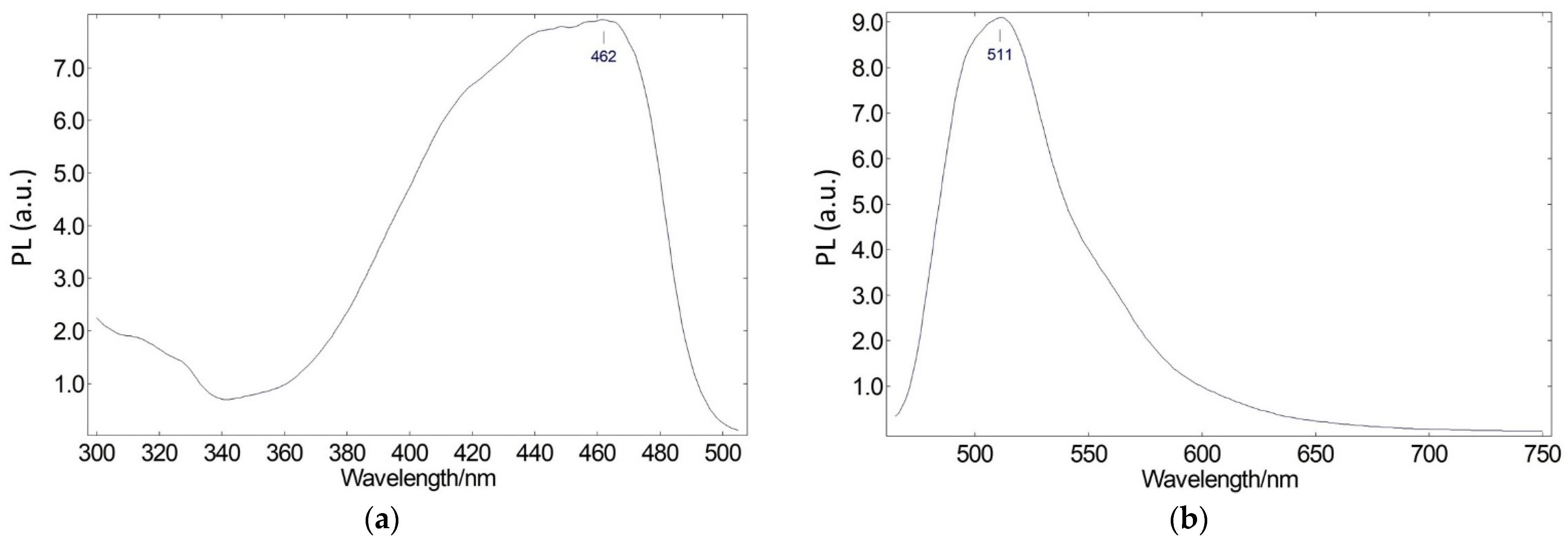
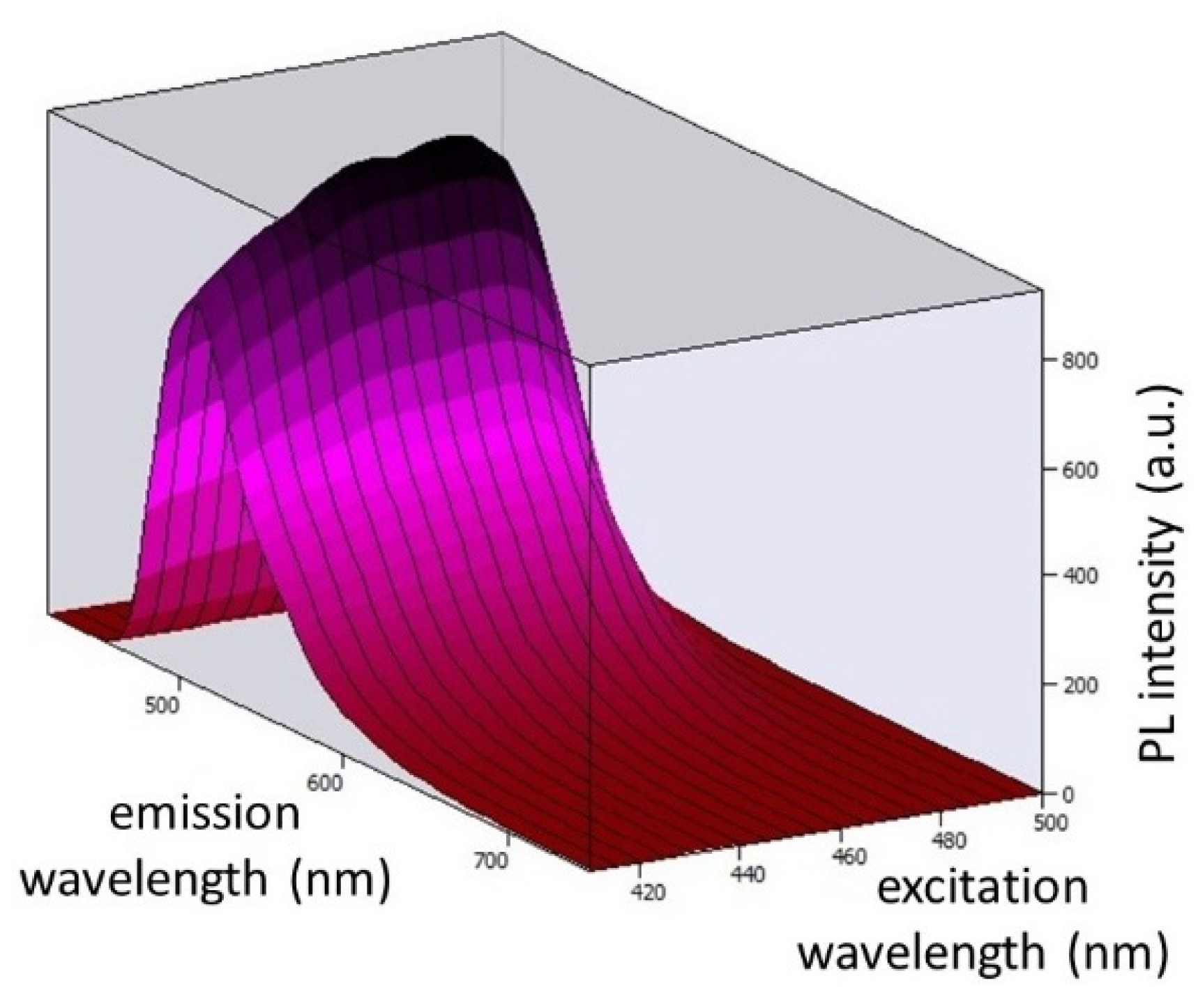
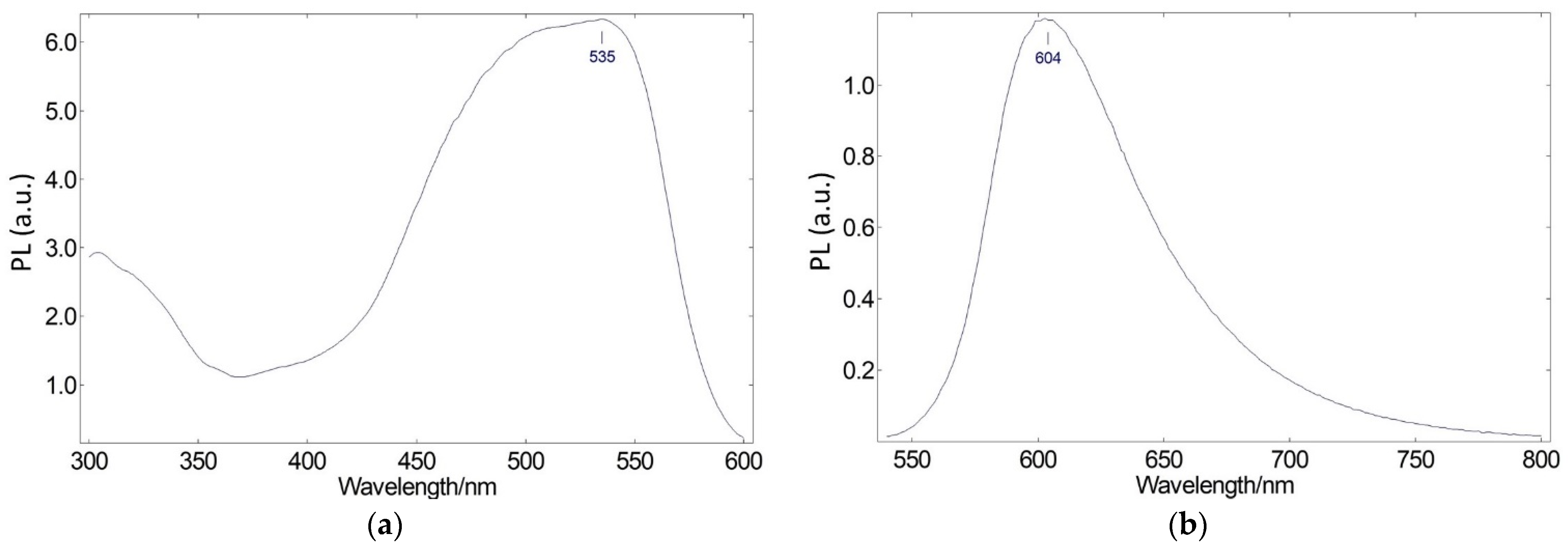
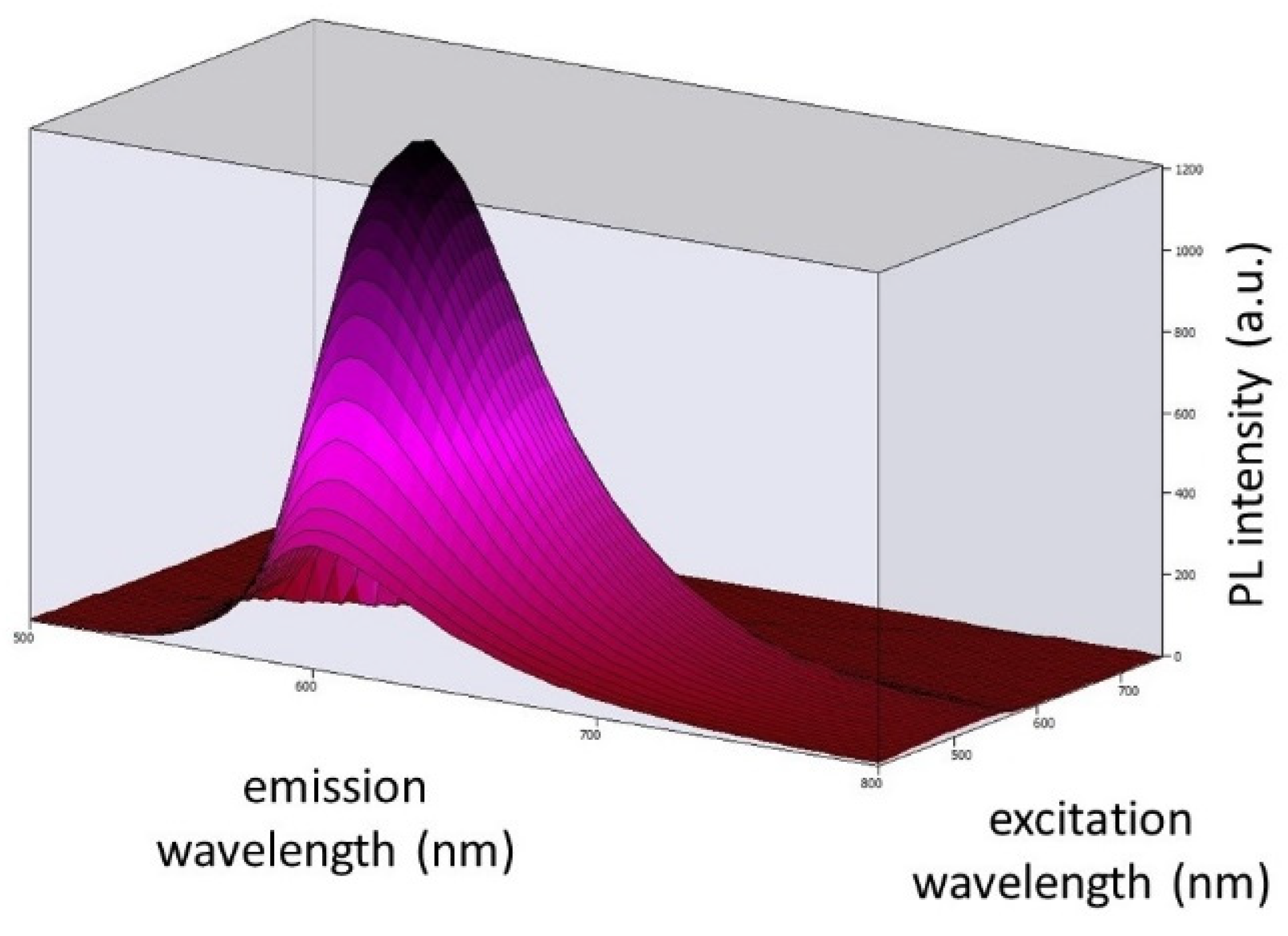
| WLED | % Dye (Layer 1) | Thickness (Layer 1) | CRI | CCT (K) |
|---|---|---|---|---|
| WLED1 | C6 0.0100% | 0.5 mm | 55.6 | 34,565 |
| WLED2 | C6 0.0175% | 0.5 mm | 36.7 | 8708 |
| WLED3 | C6 0.0250% | 0.2 mm | 43.2 | 10,046 |
| WLED | % Dye (Layer 1) | Thickness (Layer 1) | % Dye (Layer 2) | Thickness (Layer 2) | CRI | CCT (K) |
|---|---|---|---|---|---|---|
| WLED4 | C6 0.025% | 0.2 mm | NRed 0.010% | 0.2 mm | 74.1 | 6892 |
| WLED5 | NRed 0.010% | 0.2 mm | C6 0.025% | 0.2 mm | 70.7 | 6870 |
| WLED6 | C6 0.025% | 0.2 mm | NRed 0.010% | 0.5 mm | 81.2 | 4886 |
| WLED7 | NRed 0.010% | 0.5 mm | C6 0.025% | 0.2 mm | 81.1 | 5924 |
| WLED8 | C6 0.025% | 0.2 mm | NRed 0.010% | 0.8 mm | 66.4 | 3077 |
| WLED9 | NRed 0.010% | 0.8 mm | C6 0.025% | 0.2 mm | 84.9 | 4885 |
| WLED10 | C6 0.025% | 0.2 mm | NRed 0.020% | 0.2 mm | 82.7 | 5665 |
| WLED11 | NRed 0.020% | 0.2 mm | C6 0.025% | 0.2 mm | 78.5 | 6207 |
| WLED12 | C6 0.025% | 0.2 mm | NRed 0.020% | 0.5 mm | 44.6 | 2060 |
| WLED13 | NRed 0.020% | 0.5 mm | C6 0.025% | 0.2 mm | 86.2 | 3712 |
| WLED14 | C6 0.025% | 0.2 mm | NRed 0.020% | 0.8 mm | 32.6 | 1747 |
| WLED15 | NRed 0.020% | 0.8 mm | C6 0.025% | 0.2 mm | 80.6 | 2975 |
| WLED16 | C6 0.025% | 0.2 mm | NRed 0.005% | 0.2 mm | 80.3 | 6261 |
| WLED17 | NRed 0.005% | 0.2 mm | C6 0.025% | 0.2 mm | 73.8 | 6650 |
| WLED18 | C6 0.025% | 0.2 mm | NRed 0.005% | 0.5 mm | 83.0 | 5429 |
| WLED19 | NRed 0.005% | 0.5 mm | C6 0.025% | 0.2 mm | 79.1 | 6266 |
| WLED20 | C6 0.025% | 0.2 mm | NRed 0.005% | 0.8 mm | 78.5 | 4260 |
| WLED21 | NRed 0.005% | 0.8 mm | C6 0.025% | 0.2 mm | 82.6 | 5312 |
| WLED | % Dye (Layer 1) | Thickness (Layer 1) | % Dye (Layer 2) | Thickness (Layer 2) | CRI | CCT (K) |
|---|---|---|---|---|---|---|
| WLED16 | C6 0.025% | 0.2 mm | NRed 0.005% | 0.2 mm | 80.3 | 6261 |
| WLED7 | NRed 0.010% | 0.5 mm | C6 0.025% | 0.2 mm | 81.1 | 5924 |
| WLED10 | C6 0.025% | 0.2 mm | NRed 0.020% | 0.2 mm | 82.7 | 5665 |
| WLED18 | C6 0.025% | 0.2 mm | NRed 0.005% | 0.5 mm | 83.0 | 5429 |
| WLED21 | NRed 0.005% | 0.8 mm | C6 0.025% | 0.2 mm | 82.6 | 5312 |
| WLED6 | C6 0.025% | 0.2 mm | NRed 0.010% | 0.5 mm | 81.2 | 4886 |
| WLED9 | NRed 0.010% | 0.8 mm | C6 0.025% | 0.2 mm | 84.9 | 4885 |
| WLED13 | NRed 0.020% | 0.5 mm | C6 0.025% | 0.2 mm | 86.2 | 3712 |
| WLED15 | NRed 0.020% | 0.8 mm | C6 0.025% | 0.2 mm | 80.6 | 2975 |
| WLED | % Dye (Layer 1) | Thickness (Layer 1) | % Dye (Layer 2) | Thickness (Layer 2) | CRI | CCT (K) |
|---|---|---|---|---|---|---|
| WLED16 | C6 0.025% | 0.2 mm | NRed 0.005% | 0.2 mm | 80.3 | 6261 |
| WLED9 | NRed 0.010% | 0.8 mm | C6 0.025% | 0.2 mm | 84.9 | 4885 |
| WLED15 | NRed 0.020% | 0.8 mm | C6 0.025% | 0.2 mm | 80.6 | 2975 |
Disclaimer/Publisher’s Note: The statements, opinions and data contained in all publications are solely those of the individual author(s) and contributor(s) and not of MDPI and/or the editor(s). MDPI and/or the editor(s) disclaim responsibility for any injury to people or property resulting from any ideas, methods, instructions or products referred to in the content. |
© 2023 by the authors. Licensee MDPI, Basel, Switzerland. This article is an open access article distributed under the terms and conditions of the Creative Commons Attribution (CC BY) license (https://creativecommons.org/licenses/by/4.0/).
Share and Cite
Menéndez-Velázquez, A.; García-Delgado, A.B.; Morales, D. Human-Centric Lighting: Rare-Earth-Free Photoluminescent Materials for Correlated Color Temperature Tunable White LEDs. Int. J. Mol. Sci. 2023, 24, 3602. https://doi.org/10.3390/ijms24043602
Menéndez-Velázquez A, García-Delgado AB, Morales D. Human-Centric Lighting: Rare-Earth-Free Photoluminescent Materials for Correlated Color Temperature Tunable White LEDs. International Journal of Molecular Sciences. 2023; 24(4):3602. https://doi.org/10.3390/ijms24043602
Chicago/Turabian StyleMenéndez-Velázquez, Amador, Ana Belén García-Delgado, and Dolores Morales. 2023. "Human-Centric Lighting: Rare-Earth-Free Photoluminescent Materials for Correlated Color Temperature Tunable White LEDs" International Journal of Molecular Sciences 24, no. 4: 3602. https://doi.org/10.3390/ijms24043602
APA StyleMenéndez-Velázquez, A., García-Delgado, A. B., & Morales, D. (2023). Human-Centric Lighting: Rare-Earth-Free Photoluminescent Materials for Correlated Color Temperature Tunable White LEDs. International Journal of Molecular Sciences, 24(4), 3602. https://doi.org/10.3390/ijms24043602








